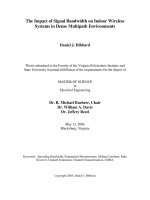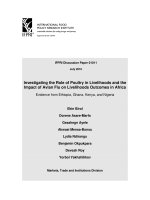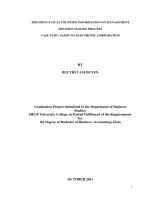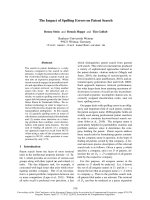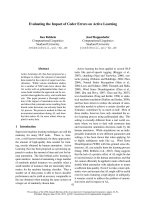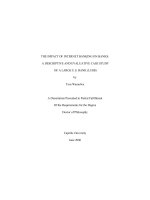Assessment the impact of ecotourism activities on biodiversity conservation in cat ba national park hai phong city
Bạn đang xem bản rút gọn của tài liệu. Xem và tải ngay bản đầy đủ của tài liệu tại đây (797.95 KB, 67 trang )
gMINISTRY OF AGRICULTURE AND RURAL DEVELOPMENT
VIETNAM NATIONAL UNIVERSITY OF FORESTRY
STUDENT THESIS
ASSESSMENT THE IMPACT OF ECOTOURISM ACTIVITIES ON BIODIVERSITY
CONSERVATION IN CAT BA NATIONAL PARK, HAI PHONG CITY
Major: Natural Resources Management
Code: D850101
Faculty: Forest Resources and Environmental Management
Student: Nguyen Thi Hang
Student ID: 1453091575
Class: K59 Natural Resources Management
Course: 2014 - 2018
Advanced Education Program
Developed in collaboration with Colorado State University, USA
Supervisor: Assoc. Prof. Dr. Dong Thanh Hai
Ha Noi, 2018
ACKNOWLEDGEMENT
I would like to express my very great appreciation to Assoc. Prof. Dr. Dong Thanh
Hai from Vietnam National Forestry University, my research supervisor, for his enthusiastic
encouragement and useful comments. Without his thoughtful, patient guidance through each
step of my research, this thesis could not be completed.
I would like to express my deepest appreciation to the head, staff of Cat Ba National
Park, the local people, the tourists for helping me enthusiastically during the data collection
and providing the useful information.
Many others have contributed to the success of this thesis, but I would especially like
to thank my family and classmates from K59 Natural Resources Management-Advanced
program for their support. Last but not least, this thesis may never have been completed
without the support of the Faculty of Forest Resources and Environmental Management
always encouraged me throughout my studies and research.
Despite spending the best efforts in the process of conducting the thesis, this research
is still lacking due to the limitations of my time, finance and ability. I look forward to
receiving feedback from teachers, friends to complete the thesis better.
Thank you!
i
ABSTRACT
The topic of "Assisting the impact of ecotourism activities on biodiversity
conservation in Cat Ba National Park, Hai Phong city" was carried out in Cat Ba National
Park, Cat Hai district, Hai Phong city.
This study is based on a survey conducted for tourists about ecotourism. The main
objective of the study was to identify the current status of ecotourism development and assess
the impacts of ecotourism on biodiversity conservation in the Cat Ba National Park then
propose solutions to limit the impact of the activities of ecotourism to the conservation of
biodiversity and improve the effectiveness of biodiversity conservation in Cat Ba National
Park. The methods used for data collection are interview and line transects survey. The study
shows that Cat Ba National Park has high value for landscape and biodiversity to develop
ecotourism, which also satisfies the level of tourists to ecotourism services. The study also
shows the remaining issues for ecotourism in Cat Ba National Park such as environmental
sanitation, facilities. The findings also suggest that there is need to create more awareness by
providing information on threats affecting biodiversity by ecotourism and its harm so as to
encourage the local leaders and community people sustainable tourism development and
conservation of natural tourism resources.
Keyword: ecotourism, biodiversity, conservation.
ii
ABBREVIATIONS
IUCN: International Union for Conservation of Nature and Natural Resources
NP: National Park
UNESCO: United Nations Educational Scientific and Cultural Organization
WWF: World Wildlife Fund
iii
TABLE OF CONTENTS
ACKNOWLEDGEMENT
ABSTRACT
ABBREVIATIONS
LIST OF FIGURES
LIST OF TABLES
I. INTRODUCTION ................................................................................................................... 1
II. LITERATURE REVIEW ...................................................................................................... 3
2.1. Overview of ecotourism ...................................................................................................... 3
2.1.1. Concept of ecotourism ...................................................................................................... 3
2.1.2. Characteristics of ecotourism ........................................................................................... 3
2.1.3. The basic principles of ecotourism ................................................................................... 4
2.2. Biodiversity and biodiversity conservation ......................................................................... 4
2.2.1. Biodiversity ...................................................................................................................... 4
2.2.2. Biodiversity conservation ................................................................................................. 5
2.3. The impact of ecotourism on biodiversity conservation ..................................................... 5
2.3.1. The positive impact of ecotourism ................................................................................... 5
2.3.2. The negative impact of ecotourism .................................................................................. 6
III. GOALS AND OBJECTIVES ............................................................................................... 7
3.1. Goals .................................................................................................................................... 7
3.2. Objectives ............................................................................................................................ 7
IV. METHODOLOGY ............................................................................................................... 8
4.1. Study site description .......................................................................................................... 8
4.1.1. Natural conditions ............................................................................................................ 8
4.1.2. Socio-Economic Conditions ........................................................................................... 10
4.2. Methodology...................................................................................................................... 11
iv
4.2.1. Secondary document review ........................................................................................... 11
4.2.2. Data collection ................................................................................................................ 12
4.2.3. Data analysis ................................................................................................................... 14
V. RESULTS AND DISCUSSION .......................................................................................... 15
5.1. Current status of ecotourism in Cat Ba National Park....................................................... 15
5.1.1. Status of infrastructure system of the Cat Ba National Park .......................................... 15
5.1.2. Tourism services ............................................................................................................. 17
5.1.3. The tourist spots and routes ............................................................................................ 19
5.1.4 Tourist characteristics ...................................................................................................... 24
5.2. Assessment of impacts of ecotourism on biodiversity conservation in Cat Ba National
Park ........................................................................................................................................... 28
5.2.1. Positive impact ............................................................................................................... 28
5.2.2. Negative impact .............................................................................................................. 34
5.3. Propose some solutions for sustainable ecotourism development in association with
biodiversity conservation in Cat Ba National Park .................................................................. 38
VI. CONCLUSION .................................................................................................................. 43
6.1. Conclusion ......................................................................................................................... 43
6.1.1. Current status of ecotourism activities at Cat Ba National Park .................................... 43
6.1.2. Impacts of ecotourism on biodiversity conservation of Cat Ba National Park .............. 43
6.1.3. Proposing solutions ........................................................................................................ 44
6.2. Constraints ......................................................................................................................... 44
6.3. Recommendation ............................................................................................................... 44
REFERENCES
APPENDIX
v
LIST OF FIGURES
Figure 4. 1 Geographic map of Cat Ba NP ................................................................................. 9
Figure 4. 2 Map of transect line survey .................................................................................... 14
Figure 5. 1 Some ecotourism routes in Cat Ba National Park .................................................. 23
Figure 5. 2 The reason tourists choose to travel in Cat Ba National Park ................................ 25
Figure 5. 3 Information sources for tourist to know Cat Ba NP ............................................... 26
Figure 5. 4 Desire to participate in ecotourism activities of the community............................ 30
Figure 5. 5 Tourism services that the community wants to be involved .................................. 30
Figure 5. 6 Tourist bring food and water to forest.................................................................... 36
Figure 5. 7 Tourist's perception of the impact of ecotourism on biodiversity conservation .... 38
vi
LIST OF TABLES
Table 5. 1 Satisfaction levels of tourists about infrastructure .................................................. 15
Table 5. 2 Satisfaction levels of tourists about tourism services .............................................. 18
Table 5. 3 Number of tourists to Cat Ba NP (period 2015-2017) ............................................ 24
Table 5. 4 Sightseeing time of tourists at Cat Ba NP ............................................................... 27
Table 5. 5 The number of times that tourists have to visit Cat Ba NP ..................................... 27
Table 5. 6 Feelings of tourists about Cat Ba NP ...................................................................... 27
Table 5. 7 Revenue from tourism of Cat Ba NP (period 2015-2017) ...................................... 28
Table 5. 8 Perception of local people about the species in Cat Ba NP ..................................... 31
Table 5. 9 Ecotourism activities in Cat Ba NP attract tourists ................................................. 32
Table 5. 10 Satisfaction levels of tourists about knowledge after trips .................................... 33
Table 5. 11 Tourists perceptions of biodiversity conservation ................................................. 33
Table 5. 12 Camping activities tourists want to participate ..................................................... 34
Table 5. 13 Satisfaction levels of tourists about environmental sanitation .............................. 35
Table 5. 14 Consciousness of tourists on general hygiene ....................................................... 35
Table 5. 15 Some activities from tourism affect the environment most................................... 37
vii
I. INTRODUCTION
Biodiversity is an important basis for the survival and development of nations.
Therefore, conservation of biodiversity has become a matter of concern, especially in the
national park and nature reserve. However, in recent years, under the impact of global climate
change, biodiversity is being seriously affected.
Ecotourism is considered one of the ways that both support biodiversity conservation
and at the same time support socio-economic development effectively. Ecotourism has
changed dramatically, gradually becoming a global trend.
Vietnam has a tropical monsoon climate with 75% of the total area is mountain and
plateau, the coast stretches over 3200km and there are many small and medium islands. In
addition, there is also a diversity of forest and marine ecosystems. The harmonious
combination of natural landscape and traditional culture is the condition and potential for
ecotourism development in Vietnam. However, it is also a great challenge in biodiversity
conservation under the impact of ecotourism.
Located in the east of Hai Phong city, Cat Ba National Park is an ideal place to
develop ecotourism. Cat Ba National Park was established on 31 March 1986 under the
No.79/CP decision of the Council of Ministers of Vietnam (now the government). It has a
beautiful natural landscape, rich vegetation with more than 1500 species. About animal, so far
282 species have been recorded. These include 32 species of mammals, 78 birds’ species, 20
species of reptiles and amphibians, 98 species of zooplankton, 196 species of marine fish and
177 species of coral (Cat Ba National Park, 2016). The most common mammals include civet,
deer, macaques, and squirrels. The island is on a major migration route for waterfowl which
feed and roost in the mangrove forest.
In addition to the benefits, tourism development also has negative impacts on the
biodiversity and conservation of Cat Ba National Park. Tourism development requires
ecosystem impact, which results in abnormal changes in the natural development tendency of
1
ecological processes. Therefore, the pressure of tourism activities on the conservation of the
national park is increasing.
This shows that tourism and conservation have a reciprocal relationship very close,
intimate, interactive support each other. In addition, development of tourism activities
irrational may become causes of the decline in the value of the resources, declining
environmental quality and thus also impair the effectiveness of tourism activities.
The development of tourism has become a pressure for Cat Ba National Park. In the
current context, research on ecotourism and its impact on biodiversity conservation in Cat Ba
National Park are necessary. However, there is no project or specific research on the level of
impact, recent research has only assessed the potential development of ecotourism in Cat Ba
National Park. In order to understand the impacts of ecotourism activities on conservation at
Cat Ba National Park and to contribute to the promotion of sustainable tourism development,
author carried out research topics: "Assessment the impact of ecotourism activities on
biodiversity conservation in Cat Ba National Park, Hai Phong city".
2
II. LITERATURE REVIEW
2.1. Overview of ecotourism
2.1.1. Concept of ecotourism
The Nature Conservancy adopts the definition articulated by the World Conservation
Union (IUCN): "Environmentally responsible travel to natural areas, in order to enjoy and
appreciate nature (and accompanying cultural features, both past and present) that promotes
conservation, have a low visitor impact and provide for beneficially active socio-economic
involvement of local peoples." Ecotourism is distinguished by its emphasis on conservation,
education, traveler responsibility and active community participation (Ceballos-Lascurain,
1996).
2.1.2. Characteristics of ecotourism
According to Dowling (Stephen & Dowling, 2002), the difference between ecotourism
and other types of tourism was listed in the following five characteristics:
- Nature-Based: Ecotourism is based on the natural environment with a focus on its
ABC features. These are Abiotic- e.g. landscapes, Biotic- plants and animals, and Culturalhuman features.
- Ecologically Sustainable: Due to ecotourism development on the abundant
environment in nature, formation and extent of use for tourism activities should be maintained
and managed for the sustainability of the ecosystem and the tourism sector.
- Environmentally Educative: The educative component of ecotourism is a key
element that separates it from all other forms of nature-based tourism. Ecotourism includes
education: In the environment; about the environment; for the environment.
- Locally Beneficial: Ecotourism always involves local communities. This can occur
through the provision of knowledge, services, facilities, and products.
3
- Tourist Satisfaction: Ecotourism, like tourism generally, strives for tourist
satisfaction. Without satisfied Eco-tourists, there is no ecotourism. Eco-tourists are becoming
better informed and more discerning.
2.1.3. The basic principles of ecotourism
According to Rinkesh (2015), ecotourism is about responsible travel to natural areas
that promote conservation, bring harmony among communities, and sustains the well-being of
local people. People who implement and participate in ecotourism activities should adopt the
following ecotourism principles:
- Minimize physical, social, behavioral, and psychological impacts
- Build environmental and cultural awareness and respect
- Provide positive experiences for both visitors and local people
- Provide direct financial benefits for environmental conservation
- Generate financial benefits for both local people and private industry
- Deliver memorable interpretative experiences to visitors that help raise sensitivity
to host countries’ political, environmental, and social climates
- Design, construct and operate low-impact facilities
2.2. Biodiversity and biodiversity conservation
2.2.1. Biodiversity
The term biodiversity was first used in 1988 (Wilson, 1988) and after the Convention on
Biological Diversity (1993) was adopted. There are many definitions of Biodiversity:
It is the variety of life on Earth, in all its forms and all its interactions. If that sounds
bewilderingly broad, that’s because it is. Biodiversity is the most complex feature of our
planet and it is the most vital. “Without biodiversity, there is no future for humanity,” (David
Macdonald, 2007). The term was coined in 1985 – a contraction of “biological diversity” –
but the huge global biodiversity losses now becoming apparent represent a crisis equaling – or
quite possibly surpassing – climate change. More formally, biodiversity is comprised of
4
several levels, starting with genes, then individual species, then communities of creatures and
finally entire ecosystems, such as forests or coral reefs, where life interplays with the physical
environment. These myriad interactions have made Earth habitable for billions of years. A
more philosophical way of viewing biodiversity is this: it represents the knowledge learned by
evolving species over millions of years about how to survive through the vastly varying
environmental conditions Earth has experienced.
According to WWF (1989): Biodiversity is the prosperity of life on earth, as hundreds
of species of plants, animals, and microorganisms, genes are contained within species and are
extremely ecosystems and it complex coexistence in the environment.
2.2.2. Biodiversity conservation
Biodiversity conservation is the process of managing the interaction between humans
and the genes, species, and ecosystems that are most beneficial to the present generation and
maintains their potential, to meet the needs and aspirations of future generations (Dictionary
of Biodiversity and Sustainable Development, 2001).
In order to be able to carry out management activities to conserve biodiversity, it is
necessary to understand the negative impacts and threats that species currently face and to
develop management approaches appropriate to reduce the negative impact of such risks.
2.3. The impact of ecotourism on biodiversity conservation
2.3.1. The positive impact of ecotourism
Dawson et al. (2015) note that ecotourism affords an opportunity to raise public
awareness through education, generate local economic benefits through tourist’s expenditure
and related business, from that hence promote conservation of threatened species and systems.
Ecotourism follows the principles that it will bring great benefits to ensure the preservation of
natural and human values. Introducing the ecosystem to tourists will contribute to raising
awareness, changing attitudes and behaviors to protect the biodiversity of tourists. Moreover,
ecotourism, through environmental interpretations, helps tourists and local communities better
5
understand the natural and human values of their place of residence. Protecting and promoting
cultural identity is an important principle that ecotourism must follow; as cultural values are
an integral part of the natural value- is also the target of national parks.
2.3.2. The negative impact of ecotourism
While specific to the context, there is a range of potential negative impacts of
ecotourism that can include disturbance to foraging, nesting or resting, habituation of wildlife
to humans through provisioning, desensitization of wildlife to humans and other potential
threats (Hughes and Carlsen, 2008). This means all ecotourism activities can affect
biodiversity conservation, which can disturb ecological and biodiversity. The development of
uncontrolled tourism can affect the soil (erosion, landslides), disturbance of habitats, threats to
wildlife (noise, hunting, etc.). Construction of roads and campsites that prevent wildlife from
moving for prey, breeding or reproduction, damaging coral reefs by specimen collection,
ornamental fish or mooring. In addition, adverse impacts may also occur to habitats and
broader ecosystems through waste, removal or trampling of flora, soil compaction, and
erosion.
6
III. GOALS AND OBJECTIVES
3.1. Goals
The general goal of the research is to assess the impact on biodiversity conservation
by ecotourism activities in Cat Ba National Park, from which to propose solutions to limiting
the impact of ecotourism activities on biodiversity conservation and improving the
effectiveness of biodiversity conservation in Cat Ba National Park
3.2. Objectives
- To identify the current status of ecotourism in Cat Ba National Park
- To assess the impacts of ecotourism on conservation at Cat Ba National Park in both
positive and negative aspects
- To give a recommendation for sustainable ecotourism development and biodiversity
conservation
7
IV. METHODOLOGY
4.1. Study site description
4.1.1. Natural conditions
4.1.1.1. Geographical location
Cat Ba Island is a limestone island with an area of over 204 km2; there are about 367
other large islands in the system of South Island Ha Long Bay. Cat Ba is the largest island of
the archipelago, the distance from Cat Ba Island to Hai Phong is 45 kilometers to the east, 25
kilometers to the south of Ha Long City and Hanoi city about 150km to the southeast. To the
north it borders Ha Long Bay, Quang Ninh province; the west it borders Cat Hai Island, Cat
Hai district, Hai Phong city; the east and south are the East Sea.
- Cat Ba island coordinates:
20042′ – 20054′ North latitude
106°52′- 107°07′ East longitude
- Cat Ba National Park coordinates:
20°44′50″-20°55′29″ North latitude
106°54′20″-107°10′05″ East longitude
8
Figure 4. 1 Geographic map of Cat Ba NP
(Source: Management Board of Cat Ba National Park)
4.1.1.2. Topography, climate, hydrology, and natural resources
Cat Ba is a tropical monsoon climate and is directly influenced by oceanic climate,
southwest monsoon in summer and northeast monsoon in winter, less harsh than areas with
the same latitude in the mainland. Cat Ba is a limestone archipelago, almost a system of rivers
and streams on the island does not develop. Temporary flows only appear in the rain and stop
immediately after rain. In the rainy season, the water is deposited in some small areas, leaking
in caves. All of Cat Ba Island is mountainous areas with elevations between 50-200m; the
average slope is 30-40 degrees. The main terrain of Cat Ba is limestone alternating with many
large and small valleys. In terms of mineral resources, in addition to limestone, Cat Ba Island
also has valuable mineral water. The Cat Ba area, as well as the northeastern part of Vietnam,
has a long history of geological development, had been a part of the folded structure
Caledonia marks the end geosynclinal regime deep sea Karatzia in late Silurian. The results of
the field survey and the secondary site mapping show that the communes inside and outside of
9
Cat Ba National Park are mostly limestone, along with the Karst topography and humid
tropical climate have formed the six main types of land.
According to the survey result of Forest Inventory and Planning Institute has identified
1,585 species include: Group of plants for wood: 432 species; Medicinal plants: 1026 species;
Food supply: 273 species; Ornamental plants and shade trees: 253 species; Group of plastic
extracts: 26 species; Group of art materials: 45 species. Of these, 53 endangered species are
listed in the Red Data Book of Vietnam (2007) and the World Red Book (2009). In addition,
Cat Ba National Park has 343 species of vertebrate in shallow fewer than 4 classes: mammals,
birds, reptiles, and amphibians. With conifers in Cat Ba National Park, there are 274 species
belonging to 79 families and 14 orders. On marine life, according to research results of
scientists from Institute of Marine Resources and Environment, Hai Phong Marine Research
Institute showed that there are 31 species of seaweed; 80 marine species; 91 species of
zooplankton; 81 species of phytoplankton; 81 species of coral.
4.1.2. Socio-Economic Conditions
According to data from Haiphong Statistical Office, population growth in Cat Ba
Island is mainly natural increase with an average of 0.68% per year (2011), lower than the
annual average of Hai Phong city and the whole country. The population is relatively stable in
recent years. The average population density of the district is 80 people /km2. The total
population of the region in 2011 is 16,566 people, the proportion of men and women in the
past few years has not changed significantly, and the proportion of women than men is
usually slightly higher.
Table 4. 1 The population situation of the commune town in Cat Ba Island
No
Commune
Total
Demography
HHs
The birth
Death
Natural increase
rate
rate
rate
1
Gia Luan
197
580
1.67
0.34
1.33
2
Phu Long
124
2,064
1.22
0.58
0.64
10
3
Hien Hao
541
354
0.42
0.28
0.14
4
Xuan Dam
451
851
1.88
1.08
0.8
5
Tran Chau
108
1,563
1.79
0.70
1.09
6
Viet Hai
249
210
0.95
0.95
0
7
Cat Ba town
4,013
10,944
1.37
0.59
0.78
Total
5,683
16,566
Average: 0,68 %
(Source: People's Committees of communes, Cat Ba town and district Statistical
Yearbook - 2011)
According to the report of the third meeting, the People's Council of Cat Hai district, the
2016-2021 term, in 2016, the economic structure of the district continues to move in the right
direction, the production value of economic services sector up 15%, the total number of
tourists more than 17 million, net revenue budget of over 109 billion. This is a good signal for
the economic development of the entire Cat Hai district, including the Cat Ba National Park.
4.2. Methodology
This research was conducted from June to October. The written proposal was written
from June to July and the fieldwork was from August 8 th , 2018 to August 20 th, 2018. From
August 25 th, 2018 to October 25 th, 2018 is the time to analyze the data and complete the
thesis.
4.2.1. Secondary document review
Before conducting data collection, the author wrote the proposed thesis; learn about the
research area through the documents, the previous studies related to information about the
study area and activities ecological tourism such as natural conditions, maps and maps
ecotourism
Step 1: Identify the data required in the research:
- Map of Cat Ba National Park.
11
- Information on the animal area, on the activities of ecotourism in this park (rare
species, their distribution).
- Human resources (folklore, culture, and traditions)
- Information on the ecotourism activities available in the national protected areas
Step 2: The inheritance data can be collected from Cat Ba National Park Management Board:
- Map of Cat Ba National Park
- The fauna and flora in Cat Ba National Park
- Information on politics - society - defense of the commune in Cat Ba town
- Information on ecotourism
Step 3: Secondary data need to be collected from external sources
- Books, newspapers: collecting information related to Cat Ba National Park
- Organization of tourism
Step 4: Collect secondary materials.
Step 5: Detailed study on the data values collected.
- Identify the data values.
- Compared with the research objectives.
- Assessment: Identification and classification of data; Reliability and usability of data.
Step 6: Obtain the necessary data collected from the original data.
4.2.2. Data collection
4.2.2.1. Preparation
- Preparation of useful equipment for data collection: pens, maps, notebooks, tools, etc.
- Identification of preliminary survey routes
- Prepare a questionnaire
4.2.2.2. Interview
Step 1: Determine the needed information on the current state of ecotourism activities, the
potential ecotourism sites, local community culture.
12
Step 2: Identify the interviewed subject: based on the information to be collected, it’s
necessary to introduce some subject as follow tourist (international and domestic tourist) and
local people.
Step 3: Develop interview questions with locals and tourists.
- For local people: The study has interviewed 40 households of 4 communes in the
locality of Cat Ba town, the object interview is the head of households and selects
randomly. The questions focused on participation in ecotourism activities of the local
people and their attitude to the conservation of biodiversity through ecotourism.
Questionnaires for local people are in Appendix 1.
- For tourists: The study has interviewed 60 tourists about travel quality and their
expectation of participating ecotourism in Cat Ba National park. Questionnaires for
tourists are in Appendix 2.
- For management and staff in Cat Ba National park: The study has interviewed 5 staffs
of Cat Ba National park. The question focused on investment in ecotourism
development in Cat Ba National Park and the conservation of biodiversity in here.
Questionnaires for staffs are in Appendix 3.
Step 4: Conduct interviews: When interviewing, the object should understand the mean of
questions, the information needs to be briefly noted.
Step 5: Synthesize, analyze and save the collected data.
4.2.2.3. Line transect survey
After collecting information from the secondary materials and interviewed method, the study
conducted a field survey by the transect line survey method:
Step 1: Creating maps for transect lines: In this study, the author created four transects
through main routes in Cat Ba National Park:
1. Kim Giao forest - Ngu Lam peak
2. Trung Trang cave- Grottos route
13
3. Trung Trang cave- Goi stream
4. May Bau peak- Ech pond
The length of transects from 3 to 4 kilometers and it takes about 2 to 4 hours for each transect
lines.
:
Transect lines survey
: Other ecotourism routes
Figure 4. 2 Map of transect line survey
Step 2: Investigate and data collection on image, geographic location and potential
characteristics of tourism, infrastructure, transport...
Step 3: Archiving, synthesizing and analyzing, classification of data collected.
4.2.3. Data analysis
- From the data collected from the research, fieldwork and survey interviews will
conduct statistical analysis and processing to make the results as a basis for the report.
- Use some basic mathematical functions such as logic functions, statistics, and math in
excel to recalculate the data.
- Draw diagrams to interpret the data collected
14
V. RESULTS AND DISCUSSION
5.1. Current status of ecotourism in Cat Ba National Park
5.1.1. Status of infrastructure system of the Cat Ba National Park
As a result of the interview with tourists, 50% of tourists were satisfied and 36.6% of tourists
were very satisfied with the facilities of Cat Ba National Park. Only 1.6% of tourists were
dissatisfied. This indicates that Cat Ba National Park has met the conditions of facilities for
tourists. The results are presented in table 5.1:
Table 5. 1 Satisfaction levels of tourists about infrastructure
Tourism services
Satisfaction levels of tourists
(Number of votes- Percentage (%))
Not satisfied
Quite
Satisfied
Very satisfied
satisfied
Infrastructure
1
7
30
22
1.6%
11.6%
50%
36.6%
(Source: Results calculated by the author based on data surveyed, 2018)
The reason for such results is that in recent years, facilities have been more
investment. Tourism business in the national park has been improved over the years, such as
upgrading infrastructure, opening more tourist and educational routes in Ang Vat, improving
road patrols combining tourism and road repair to Kim Giao forest, Ngu Lam peak, Trung
Trang cave, ... to meet the increasing demand and diversity of tourists.
- Water, electricity and communication systems:
+ Electrical system: Cat Ba NP is now a separate substation to supply electricity to
areas in the park. Lines and transformers have been pulled to almost all communes in the NP,
ensuring that people have access to electricity.
+ Communication system: Telephone coverage throughout the island (internet available)
+ Water system: Tap water temporarily meets people's consumption needs.
15
- Traffic: tourists visit Cat Ba by both land and sea. There are high-speed trains and
ferries so travelers can move from the mainland to the island, and then they need to go by car
to the park.
- Foodservice: The food service at the National Park is very convenient, attractive. In
the context of ecological natural, tourists will enjoy the unique cuisine with local specialties in
the dining room of the Tourist Center (300m2 wide) with more than 30 tables or restaurants
"Kim Giao".
At present, Cat Ba NP has established a number of tourist sites in the service
department of the national park management board, including:
- At the National Park Center have three types of accommodation totaling more than
30 rooms with a capacity of 180 to 220 people. The rooms are divided into several levels of
service to suit the price and each customer. In general, the accommodation at Cat Ba National
Park is well equipped for tourism activities.
- Building roads in the area of administrative services, electricity and water systems.
- Building propagandists, educating the environment, having enough equipment to
support propagation and publicity.
- Establishment of a service center for tourism and environmental education under
the control of Cat Ba National Park. This center has the function of managing and
implementing propaganda campaigns, education resources, and environmental protection; to
deploy scientific research and international cooperation services, combining nursing, ecotourism, and environmental services in national parks.
- Cat Ba National Park and Cat Hai district cooperate to build Center of visitors,
cruise ship terminal and charging points at Beo station to manage tourism activities in Lan Ha
Bay. The emphasis on building and upgrading infrastructure has helped tourists enjoy marine
ecotourism, providing essential information for tourism and education to raise awareness of
16
environmental protection. This activity also contributes to effective communication and
education of aquaculture farmers, thus reducing negative impacts on the environment.
It can be seen that the system of infrastructure for tourism service primarily for the
conservation of biodiversity, gene sources of plants and animals, propagation and education
of the environment. The infrastructure system is mainly located in Cat Ba town and
surrounding areas. In general, the infrastructure, technical infrastructure for ecotourism in Cat
Ba NP is relatively full and comfortable.
Since 2008, Cat Ba National Park has invested in repairing and upgrading
infrastructure and technology for tourism services such as Cat Ba Eco Lodge resort, Nam Cat
Island resort and Trung Trang Cave. From 2017, Cat Ba National Park and the Cat Ba
Archipelago Biosphere Reserve will strive to improve the quality of tourism infrastructure.
Although there are signs of improvement but the infrastructure, tourism facilities of
Cat Ba NP are not enough, not diversified, not create a great attraction for tourists. Therefore,
to promote the tourism potential of Cat Ba Island in general and Cat Ba NP in particular, one
of the issues that need to be improved is to attract investment effectively to develop the region
as well as preserve and maintain biodiversity.
5.1.2. Tourism services
The Center for Tourism Services and Environmental Education Cat Ba National Park
organizes tourism programs for tourists who wish to visit, explore and study the landscape
environment with the following categories:
-
Ecotourism services: With the routes to Cat Ba NP, tourists can experience the
space of the forest and mountains of Cat Ba; learn the ecosystems, typical communities of the
National Park.
-
Research services: Support the research work of national and international
scientific organizations on Cat Ba island ecological environment, rare species of plants and
17

